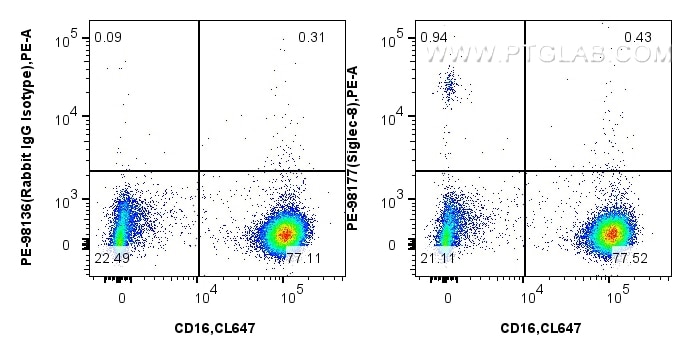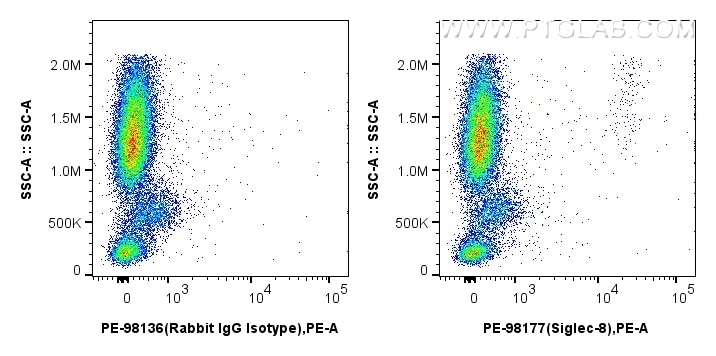Validation Data Gallery
Tested Applications
| Positive FC detected in | human peripheral blood leukocytes |
Recommended dilution
| Application | Dilution |
|---|---|
| This reagent has been pre-titrated and tested for flow cytometric analysis. The suggested use of this reagent is 5 ul per 10^6 cells in a 100 µl suspension or 5 ul per 100 µl of whole blood. | |
| Sample-dependent, Check data in validation data gallery. | |
Product Information
PE-98177 targets Siglec-8 in FC applications and shows reactivity with human samples.
| Tested Reactivity | human |
| Host / Isotype | Rabbit / IgG |
| Class | Recombinant |
| Type | Antibody |
| Immunogen | Recombinant Protein 相同性解析による交差性が予測される生物種 |
| Full Name | sialic acid binding Ig-like lectin 8 |
| Calculated molecular weight | 499 aa, 54 kDa |
| GenBank accession number | BC053319 |
| Gene Symbol | SIGLEC8 |
| Gene ID (NCBI) | 27181 |
| Conjugate | PE Fluorescent Dye |
| Excitation/Emission maxima wavelengths | 496 nm, 565 nm / 578 nm |
| Form | Liquid |
| Purification Method | Protein A purification |
| UNIPROT ID | Q9NYZ4 |
| Storage Buffer | PBS with 0.09% sodium azide and 0.5% BSA , pH 7.3 |
| Storage Conditions | Store at 2-8°C. Avoid exposure to light. Stable for one year after shipment. |
Background Information
Sialic acid-binding Ig-like lectin 8 (Siglec-8), also known as SAF2, is a sialic acid-binding immunoglobulin-like lectin that belongs to the SIGLEC family of the Ig superfamily (PMID: 10856141). Siglec-8 is a single-pass transmembrane protein containing three extracellular immunoglobulin-like domains, a transmembrane region, and a cytoplasmic tail (PMID: 10625619). It is an inhibitory receptor selectively expressed on human mast cells and eosinophils, and at low levels on basophils (PMID: 10856141; 33374255). Engagement of Siglec-8 with antibody results in inhibiting IgE-mediated mast cell responses and reducing allergic inflammation (PMID: 32814824).
Protocols
| Product Specific Protocols | |
|---|---|
| FC protocol for PE Siglec-8 antibody PE-98177 | Download protocol |
| Standard Protocols | |
|---|---|
| Click here to view our Standard Protocols |

